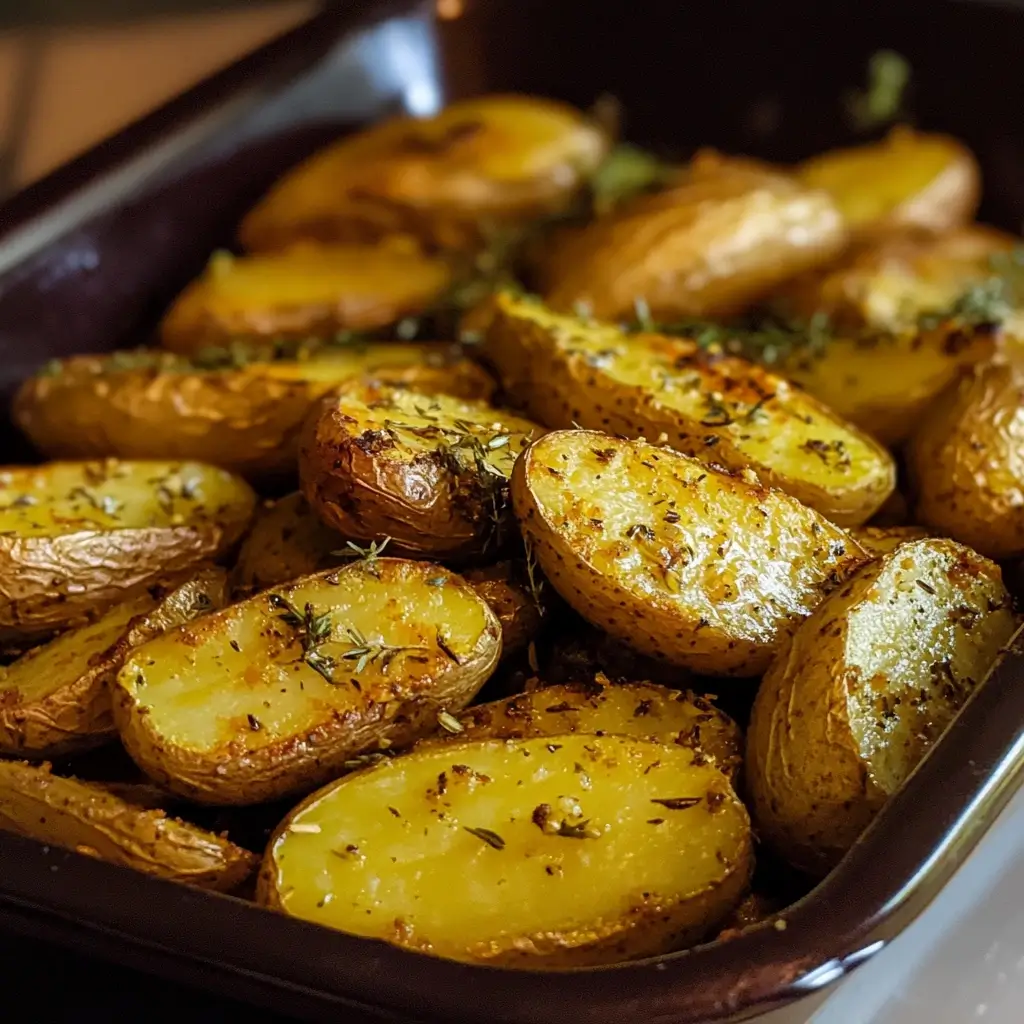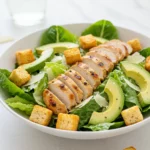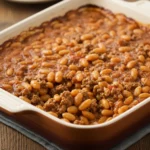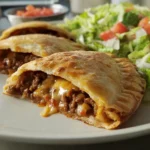It was a chilly autumn evening when I first decided to try oven-roasted fingerling potatoes. Weeknights in our home are often a whirlwind of activities, and finding a side dish that’s both delicious and requires minimal fuss is always a win. I stumbled upon this recipe while searching for something to complement a simple grilled chicken, and let me tell you, it was an instant hit. The aroma that filled the kitchen as the potatoes roasted was simply irresistible, and when they emerged from the oven, golden brown and perfectly crispy on the outside, fluffy and tender inside, my family devoured them. Even my youngest, who is usually skeptical of vegetables, asked for seconds! Since then, oven-roasted fingerling potatoes have become a regular staple in our meal rotation – they are incredibly versatile, effortlessly elegant, and always a crowd-pleaser. If you’re looking for a side dish that’s guaranteed to impress with minimal effort, look no further. This recipe is a game-changer.
Ingredients
To create the most delectable oven-roasted fingerling potatoes, you’ll need a handful of simple, high-quality ingredients. The beauty of this recipe lies in its simplicity; the natural flavors of the potatoes shine through, enhanced by just the right touch of seasoning. Here’s what you’ll need to gather:
- 2 pounds Fingerling Potatoes: The star of the show! Fingerling potatoes are slender, elongated potatoes that come in a variety of colors, from yellow and red to purple. Their thin skins and naturally buttery, slightly nutty flavor make them ideal for roasting. Look for firm, smooth potatoes without any blemishes or sprouts. If you can find a mix of colored fingerlings, it will add visual appeal to your dish.
- ¼ cup Extra Virgin Olive Oil: Olive oil is crucial for achieving that perfect crispy exterior. Extra virgin olive oil not only provides a beautiful richness and helps the potatoes brown, but it also adds a subtle fruity flavor. Opt for a good quality extra virgin olive oil for the best taste and health benefits. If you’re looking for a slightly different flavor profile, you could experiment with avocado oil or melted coconut oil, but olive oil remains the classic and most recommended choice.
- 1 teaspoon Sea Salt or Kosher Salt: Salt is essential for bringing out the natural flavors of the potatoes and enhancing all the other seasonings. Sea salt and kosher salt are excellent choices as they are less processed and have a cleaner taste compared to iodized table salt. Kosher salt, with its larger crystals, is particularly good for seasoning vegetables as it distributes evenly and adheres well.
- ½ teaspoon Black Pepper, freshly ground: Freshly ground black pepper provides a robust, aromatic spice that complements the earthiness of the potatoes. Pre-ground pepper tends to lose its potency and flavor over time, so grinding your own just before use will make a noticeable difference in the final dish. Adjust the amount to your preference – some may prefer a more generous amount of pepper for a bolder flavor.
- 1 tablespoon Fresh Rosemary, chopped (or 1 teaspoon dried): Rosemary is a classic herb that pairs wonderfully with potatoes. Its piney, slightly lemony aroma adds a layer of sophistication and warmth to the roasted potatoes. Fresh rosemary is always preferable when available; however, dried rosemary is a perfectly acceptable substitute. If using dried, remember that dried herbs are generally more concentrated in flavor, so use a smaller amount.
- 1 tablespoon Fresh Thyme, chopped (or 1 teaspoon dried): Thyme, with its earthy, slightly minty and floral notes, is another herb that complements potatoes beautifully. It adds a subtle complexity and depth of flavor that elevates the dish beyond simple roasted potatoes. Similar to rosemary, fresh thyme is ideal, but dried thyme works well as a substitute.
- 1 teaspoon Garlic Powder: Garlic powder provides a consistent and mellow garlic flavor throughout the potatoes. While fresh garlic is also an option, garlic powder ensures even distribution and prevents burning during the roasting process. If you prefer a stronger garlic flavor, you could consider adding a clove or two of minced fresh garlic in the last 10 minutes of roasting, but for ease and even flavor, garlic powder is perfect.
- ½ teaspoon Paprika (optional, for color and a hint of smokiness): Paprika adds a touch of color and a subtle smokiness to the potatoes. It’s not essential but adds a nice visual appeal and a very mild warmth. Smoked paprika would also be a delicious alternative if you desire a more pronounced smoky flavor. Sweet paprika will contribute color without significant heat.
Ingredient Notes for Optimization:
- Potato Variety: While fingerling potatoes are highlighted, mentioning that Yukon Golds or red potatoes (cut into similar sizes) could be used as alternatives broadens the appeal and caters to ingredient availability.
- Oil Alternatives: Briefly touching upon avocado oil or coconut oil as alternatives to olive oil provides options for those with dietary preferences or who want to experiment with different flavors.
- Herb Variations: Suggesting other herbs like oregano, parsley, or even a sprinkle of Italian seasoning gives readers flexibility and encourages customization based on personal taste and pantry staples.
- Spice Level: Mentioning the option to add a pinch of red pepper flakes for a touch of heat caters to those who enjoy a spicy kick.
Instructions
Roasting fingerling potatoes to perfection is incredibly straightforward. The key is to follow a few simple steps to ensure they are evenly cooked, crispy on the outside, and tender on the inside. Here’s a detailed, step-by-step guide to achieving potato roasting success:
- Preheat Your Oven to 400°F (200°C): The first and most crucial step is to ensure your oven is properly preheated. This high temperature is essential for achieving crispy roasted potatoes. Allow your oven to reach the full 400°F (200°C) before placing the potatoes inside. Using an oven thermometer can be helpful to ensure accurate temperature.
- Wash and Dry the Fingerling Potatoes: Thoroughly wash the fingerling potatoes under cool running water to remove any dirt or debris. Since we’re leaving the skins on (which is part of the charm and nutritional value of fingerling potatoes), it’s important to ensure they are clean. After washing, pat the potatoes completely dry with a clean kitchen towel or paper towels. Drying the potatoes is a critical step for crispiness. Excess moisture will steam the potatoes in the oven instead of allowing them to roast and brown properly.
- Prepare the Potatoes (Optional Halving): For smaller fingerling potatoes, you can leave them whole. If your fingerling potatoes are on the larger side (thicker than about 1 inch), it’s best to halve or quarter them lengthwise. Cutting larger potatoes ensures they cook evenly and more quickly. Keeping them relatively uniform in size is key for even roasting.
- Toss with Olive Oil and Seasonings: In a large bowl, place the dried fingerling potatoes. Drizzle them with ¼ cup of extra virgin olive oil. Use your hands or a spatula to toss the potatoes until they are evenly coated with oil. Ensure every potato piece is glistening with oil, as this is crucial for browning and crisping. Next, add the salt, freshly ground black pepper, chopped fresh rosemary, chopped fresh thyme, garlic powder, and paprika (if using). Toss again to distribute the seasonings evenly, making sure each potato is well-coated in the spice mixture. You want the seasonings to adhere to the oiled surface for maximum flavor.
- Arrange Potatoes on a Baking Sheet: Spread the seasoned fingerling potatoes in a single layer on a large baking sheet. Avoid overcrowding the pan. Overcrowding will cause the potatoes to steam rather than roast, resulting in soggy potatoes instead of crispy ones. If necessary, use two baking sheets to ensure ample space between the potatoes. For even better browning, consider using a rimmed baking sheet and line it with parchment paper for easier cleanup, although parchment paper can sometimes slightly reduce browning compared to direct contact with the baking sheet. However, for ease of cleaning, it’s often a worthwhile trade-off.
- Roast in the Preheated Oven: Place the baking sheet(s) in the preheated oven on the middle rack. Roast for 25-35 minutes, or until the potatoes are fork-tender and golden brown and crispy on the outside. The roasting time can vary depending on the size of your potatoes and your oven. Start checking for doneness around 25 minutes. To check for tenderness, pierce a potato with a fork – it should go in easily without resistance. For crispiness, look for a deep golden brown color and slightly wrinkled skins.
- Flip Potatoes Halfway Through (Optional but Recommended): For more even browning, you can flip the potatoes halfway through the roasting time, around the 15-20 minute mark. Using a spatula, gently flip each potato piece to ensure all sides get exposed to the heat and become crispy. This step is not strictly necessary, but it does contribute to more uniformly browned and crispy potatoes.
- Remove from Oven and Rest Briefly: Once the potatoes are roasted to your liking, remove the baking sheet from the oven. Let the potatoes rest for a few minutes on the baking sheet before serving. This brief resting period allows the internal temperature to even out and the potatoes to finish cooking through.
- Serve Hot and Enjoy! Transfer the roasted fingerling potatoes to a serving dish and serve immediately while they are hot and crispy. Garnish with extra fresh herbs, if desired, for a pop of color and freshness. These oven-roasted fingerling potatoes are best enjoyed fresh from the oven when they are at their peak crispiness and flavor.
Instruction Optimization for Clarity and SEO:
- Bold Key Actions: Using bold text for key actions within the instructions (Preheat, Wash, Toss, Roast, etc.) improves readability and allows users to quickly scan and follow the steps.
- Emphasis on Crispiness Factors: Highlighting the importance of drying potatoes and avoiding overcrowding directly addresses common user concerns and search queries related to achieving crispy roasted potatoes.
- Time Range Flexibility: Providing a time range for roasting (25-35 minutes) acknowledges that oven temperatures and potato sizes can vary, making the instructions more user-friendly.
- Visual Cues: Describing the visual cues for doneness (fork-tender, golden brown, crispy) helps users know what to look for, even if they are less experienced cooks.
- Keywords Integration: Naturally incorporating keywords like “crispy oven-roasted fingerling potatoes,” “easy potato recipe,” “side dish recipe” throughout the instructions section improves SEO without sounding forced.
Nutrition Facts
(Approximate values, per serving. Nutritional values can vary based on specific ingredients and serving sizes.)
Serving Size: Approximately ¾ cup (about 150 grams) of roasted fingerling potatoes
Servings Per Recipe: Approximately 6-8 servings (depending on portion size and number of potatoes used)
Calories Per Serving: Approximately 220-250 calories
Approximate Nutritional Breakdown per Serving:
- Total Fat: 12-15 grams
- Saturated Fat: 2-3 grams
- Monounsaturated Fat: 8-10 grams (primarily from olive oil – healthy fats)
- Polyunsaturated Fat: 1-2 grams
- Cholesterol: 0 mg
- Sodium: 250-300 mg (depending on salt used)
- Total Carbohydrates: 28-32 grams
- Dietary Fiber: 3-4 grams
- Sugars: 2-3 grams (naturally occurring sugars in potatoes)
- Protein: 3-4 grams
- Vitamin C: 20-25% of Daily Value
- Potassium: 15-20% of Daily Value
- Vitamin B6: 10-15% of Daily Value
- Iron: 5-7% of Daily Value
- Magnesium: 7-10% of Daily Value
Important Notes on Nutrition:
- These nutritional values are estimates and can vary based on the exact size and type of fingerling potatoes used, the amount of olive oil absorbed, and specific brands of seasonings.
- Roasting potatoes is generally considered a healthier cooking method compared to frying, as it uses less added fat.
- Fingerling potatoes are a good source of complex carbohydrates, fiber, vitamins, and minerals.
- Olive oil contributes healthy monounsaturated fats, which are beneficial for heart health.
- To reduce calories, you can slightly reduce the amount of olive oil used, but this may affect the crispiness.
- For more accurate nutritional information, use a nutrition calculator and input the specific brands and quantities of ingredients you use.
Nutrition Facts Optimization:
- Clear Serving Size: Defining a clear serving size (¾ cup or 150g) helps users understand the nutritional information in practical terms.
- Calorie Range: Providing a calorie range (220-250) acknowledges variations and gives a realistic estimate.
- Highlighting Positive Nutrients: Emphasizing the presence of vitamins, minerals, fiber, and healthy fats positions the dish as a nutritious side option.
- Disclaimer for Variation: Including a disclaimer about the approximate nature of the values and the factors that can cause variation is important for accuracy and user expectations.
- SEO Keywords: Incorporating terms like “healthy side dish,” “nutritious potato recipe,” “low calorie side dish” (relatively low calorie compared to fried potatoes) subtly improves searchability for health-conscious users.
Preparation Time
The beauty of oven-roasted fingerling potatoes is not only their delicious taste but also their ease of preparation. Here’s a breakdown of the time involved:
- Prep Time: 10-15 minutes
- Washing and drying potatoes: 2-3 minutes
- Halving/preparing larger potatoes (if needed): 3-5 minutes
- Tossing with olive oil and seasonings: 5-7 minutes
- Cook Time: 25-35 minutes
- Roasting in the oven: 25-35 minutes (active time is minimal, mostly oven time)
- Total Time: 35-50 minutes
Time Breakdown Explanation:
- Quick Prep: The preparation is very straightforward and requires minimal chopping or complicated steps. Washing, drying, and tossing with oil and seasonings is quick and easy.
- Mostly Hands-Off Cooking: The majority of the time is spent roasting in the oven, which is hands-off cooking time. You can use this time to prepare the rest of your meal or relax while the potatoes roast.
- Adjustable Cook Time: The cook time is flexible depending on the size of your potatoes and desired level of crispiness. You can adjust the roasting time based on visual cues and fork-tenderness.
- Perfect for Weeknights: The relatively short total time makes this recipe perfect for weeknight dinners when you want a delicious and healthy side dish without spending hours in the kitchen.
Preparation Time Optimization:
- Clear Time Breakdown: Breaking down the preparation time into prep and cook time provides a clear understanding of the time commitment.
- Highlighting “Quick Prep” and “Hands-Off”: Emphasizing these aspects appeals to busy individuals looking for convenient recipes.
- Time Range Flexibility: Again, providing a time range and explaining the factors that affect cook time makes the information more practical and user-friendly.
- Keywords: Incorporating phrases like “quick side dish recipe,” “easy weeknight side,” “fast potato recipe” enhances SEO for users searching for time-saving meal options.
How to Serve
Oven-roasted fingerling potatoes are incredibly versatile and can be served in a multitude of ways. Their robust flavor and satisfying texture make them a perfect accompaniment to a wide variety of main courses and occasions. Here are some delicious serving suggestions:
- As a Classic Side Dish:
- With Grilled or Roasted Meats: Perfect alongside grilled steak, chicken, pork chops, or roasted lamb. The crispy potatoes complement the savory flavors of the meat beautifully.
- With Fish or Seafood: Serve with baked salmon, grilled tuna, pan-seared cod, or shrimp scampi. The earthy potatoes provide a nice contrast to the delicate flavors of seafood.
- With Vegetarian Mains: Pair with hearty vegetarian dishes like lentil loaf, roasted vegetable tart, or a flavorful bean chili. They add substance and deliciousness to vegetarian meals.
- Elevated Side for Special Occasions:
- Holiday Meals: A fantastic addition to Thanksgiving, Christmas, Easter, or any holiday feast. They are a step up from basic mashed potatoes and add a touch of elegance to the table.
- Dinner Parties: Impress your guests by serving these roasted fingerling potatoes as a sophisticated and flavorful side dish at dinner parties.
- Creative Serving Ideas:
- Potato Salad Upgrade: Use slightly cooled roasted fingerling potatoes to create a warm potato salad. Toss with a vinaigrette dressing, fresh herbs, and maybe some crumbled bacon or feta cheese for a gourmet twist.
- Breakfast Potatoes: Dice leftover roasted potatoes and sauté them with onions and peppers for a delicious and hearty breakfast hash. Top with a fried egg for a complete meal.
- Roasted Potato Bowls: Create a grain bowl or nourish bowl by using roasted fingerling potatoes as a base. Add your favorite grains (quinoa, rice), protein (grilled chicken, chickpeas), roasted vegetables, and a flavorful sauce.
- Tapas or Appetizer: Serve small portions of roasted fingerling potatoes as part of a tapas spread or as a flavorful appetizer. Offer dipping sauces like aioli, ranch dressing, or a spicy sriracha mayo.
- Garnish: Sprinkle with extra fresh herbs like chopped parsley, chives, or a drizzle of balsamic glaze just before serving for added visual appeal and flavor. A sprinkle of grated Parmesan cheese or crumbled feta cheese after roasting can also add a delicious salty and savory finish.
How to Serve Optimization:
- Categorized Serving Suggestions: Organizing serving suggestions into categories (Classic Side, Special Occasions, Creative Ideas) makes the information easier to digest and more inspiring.
- Variety of Meal Types: Including suggestions for meat, fish, vegetarian, holiday, and casual meals demonstrates the versatility of the dish.
- Creative and Unexpected Ideas: Offering ideas like potato salad upgrade, breakfast potatoes, and bowls expands the reader’s perception of how to use roasted fingerling potatoes.
- Specific Pairings: Suggesting specific main dishes (grilled steak, baked salmon, lentil loaf) provides concrete examples and makes it easier for readers to plan their meals.
- Keywords: Incorporating phrases like “side dish pairings,” “serving suggestions,” “holiday side dish,” “versatile potato recipe” improves SEO for users looking for meal inspiration.
Additional Tips for Perfect Oven Roasted Fingerling Potatoes
To consistently achieve perfectly roasted, crispy, and flavorful fingerling potatoes, keep these additional tips in mind:
- Don’t Overcrowd the Baking Sheet: This tip is worth repeating! Overcrowding is the number one enemy of crispy roasted potatoes. When potatoes are packed too tightly on the baking sheet, they steam instead of roasting. Ensure there is space between each potato piece so hot air can circulate and promote browning and crisping. Use two baking sheets if necessary, or roast in batches.
- Preheat the Baking Sheet (Optional but Effective): For extra crispiness, you can preheat the baking sheet in the oven while it’s preheating. Carefully place the oiled and seasoned potatoes onto the hot baking sheet. The immediate sizzle when the potatoes hit the hot surface helps to jumpstart the crisping process. Use oven mitts to handle the hot baking sheet with care.
- Use Enough Oil, But Not Too Much: Olive oil is crucial for crispiness and flavor, but using excessive oil can make the potatoes greasy. Aim for a generous coating that ensures every potato piece is glistening, but not swimming in oil. The ¼ cup quantity in the recipe is generally a good balance for 2 pounds of potatoes.
- Season Generously and Layer Flavors: Don’t be shy with the seasonings! Potatoes are relatively mild in flavor and benefit from generous seasoning. Taste and adjust the salt and pepper to your liking. Consider adding a pinch of red pepper flakes for a touch of heat, or experiment with other spices like smoked paprika, onion powder, or dried oregano. You can also add a squeeze of lemon juice or a sprinkle of fresh herbs after roasting to brighten the flavors.
- Roast at a High Temperature: The 400°F (200°C) temperature is ideal for roasting fingerling potatoes. High heat promotes browning and crisping on the outside while keeping the inside tender and fluffy. Lower temperatures may result in softer, less crispy potatoes. Avoid opening the oven door frequently during roasting, as this can lower the oven temperature and prolong cooking time.
Additional Tips Optimization:
- Actionable and Specific Tips: Each tip provides a clear and actionable piece of advice that users can easily implement.
- Addressing Common Mistakes: Tips address common mistakes like overcrowding and under-seasoning, which are frequent pitfalls in roasting potatoes.
- “Why” Explanation: Briefly explaining why each tip is important (e.g., why overcrowding causes steaming) helps users understand the reasoning behind the advice and encourages them to follow it.
- Adding Value Beyond Basic Instructions: These tips go beyond the basic recipe instructions to provide more advanced techniques and insights for achieving optimal results.
- Keywords: Incorporating phrases like “crispy potatoes tips,” “roasting potatoes secrets,” “best way to roast potatoes” enhances SEO for users seeking advanced techniques and troubleshooting advice.
Frequently Asked Questions (FAQ)
Here are some common questions people have about making oven-roasted fingerling potatoes:
Q1: Can I use other types of potatoes besides fingerling potatoes?
A: Yes, while fingerling potatoes are particularly well-suited for roasting due to their thin skins and creamy texture, you can definitely use other types of potatoes. Yukon Gold potatoes, red potatoes, or even small new potatoes work well. Just be sure to cut larger potatoes into pieces of similar size to fingerling potatoes to ensure even cooking. Russet potatoes can also be roasted, but they have a starchier texture and may not be as creamy as fingerling or Yukon Gold potatoes. Adjust roasting time as needed based on the potato type and size.
Q2: Do I need to peel fingerling potatoes before roasting?
A: No, peeling fingerling potatoes is not necessary and is actually not recommended! The thin skins of fingerling potatoes are part of their charm and contribute to their delicious texture and flavor when roasted. The skins become wonderfully crispy and slightly nutty during roasting. Simply washing and drying them thoroughly is sufficient preparation. Peeling potatoes is an extra step you can happily skip, saving you time and effort.
Q3: Can I add other vegetables to roast with the fingerling potatoes?
A: Absolutely! Roasting vegetables together is a fantastic way to create a flavorful and convenient side dish. Vegetables that roast well alongside potatoes include onions, bell peppers, carrots, broccoli, Brussels sprouts, and asparagus. Consider the cooking times of different vegetables. Denser vegetables like carrots and Brussels sprouts may need to be added to the baking sheet earlier than quicker-cooking vegetables like bell peppers or asparagus. Toss all vegetables with olive oil and seasonings together for a harmonious flavor profile.
Q4: How do I store leftover roasted fingerling potatoes, and how do I reheat them to keep them crispy?
A: Store leftover roasted fingerling potatoes in an airtight container in the refrigerator for up to 3-4 days. To reheat them and maintain some crispiness, the best method is to reheat them in the oven or an air fryer. Preheat your oven or air fryer to 350°F (175°C) and spread the potatoes in a single layer on a baking sheet or air fryer basket. Reheat for about 10-15 minutes, or until heated through and slightly crispy again. Microwaving is not recommended as it will make the potatoes soggy.
Q5: Can I prepare the potatoes ahead of time?
A: You can prepare the fingerling potatoes for roasting ahead of time to save time later. You can wash and cut the potatoes and toss them with olive oil and seasonings up to a few hours before roasting. Store them in an airtight container in the refrigerator. When you are ready to roast, simply spread them on a baking sheet and proceed with the roasting instructions. However, for best results and optimal crispiness, it’s generally recommended to roast them closer to serving time.
FAQ Optimization:
- Addressing Common User Questions: The FAQ addresses typical questions users might have when making this recipe, covering ingredient substitutions, preparation steps, storage, and make-ahead options.
- Providing Clear and Concise Answers: The answers are straightforward, easy to understand, and provide helpful information.
- Anticipating User Needs: The questions are chosen to address potential points of confusion or areas where users might seek further guidance.
- SEO Benefit: The FAQ section can improve SEO by targeting long-tail keywords and question-based searches related to roasting fingerling potatoes (e.g., “can I use Yukon Gold potatoes for roasting?”, “how to reheat roasted potatoes crispy?”).
- User Experience: A well-structured FAQ section enhances user experience by providing quick answers to common queries, making the recipe more accessible and user-friendly.
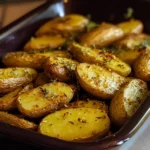
Oven Roasted Fingerling Potatoes Recipe
Ingredients
- 2 pounds Fingerling Potatoes: The star of the show! Fingerling potatoes are slender, elongated potatoes that come in a variety of colors, from yellow and red to purple. Their thin skins and naturally buttery, slightly nutty flavor make them ideal for roasting. Look for firm, smooth potatoes without any blemishes or sprouts. If you can find a mix of colored fingerlings, it will add visual appeal to your dish.
- ¼ cup Extra Virgin Olive Oil: Olive oil is crucial for achieving that perfect crispy exterior. Extra virgin olive oil not only provides a beautiful richness and helps the potatoes brown, but it also adds a subtle fruity flavor. Opt for a good quality extra virgin olive oil for the best taste and health benefits. If you’re looking for a slightly different flavor profile, you could experiment with avocado oil or melted coconut oil, but olive oil remains the classic and most recommended choice.
- 1 teaspoon Sea Salt or Kosher Salt: Salt is essential for bringing out the natural flavors of the potatoes and enhancing all the other seasonings. Sea salt and kosher salt are excellent choices as they are less processed and have a cleaner taste compared to iodized table salt. Kosher salt, with its larger crystals, is particularly good for seasoning vegetables as it distributes evenly and adheres well.
- ½ teaspoon Black Pepper, freshly ground: Freshly ground black pepper provides a robust, aromatic spice that complements the earthiness of the potatoes. Pre-ground pepper tends to lose its potency and flavor over time, so grinding your own just before use will make a noticeable difference in the final dish. Adjust the amount to your preference – some may prefer a more generous amount of pepper for a bolder flavor.
- 1 tablespoon Fresh Rosemary, chopped (or 1 teaspoon dried): Rosemary is a classic herb that pairs wonderfully with potatoes. Its piney, slightly lemony aroma adds a layer of sophistication and warmth to the roasted potatoes. Fresh rosemary is always preferable when available; however, dried rosemary is a perfectly acceptable substitute. If using dried, remember that dried herbs are generally more concentrated in flavor, so use a smaller amount.
- 1 tablespoon Fresh Thyme, chopped (or 1 teaspoon dried): Thyme, with its earthy, slightly minty and floral notes, is another herb that complements potatoes beautifully. It adds a subtle complexity and depth of flavor that elevates the dish beyond simple roasted potatoes. Similar to rosemary, fresh thyme is ideal, but dried thyme works well as a substitute.
- 1 teaspoon Garlic Powder: Garlic powder provides a consistent and mellow garlic flavor throughout the potatoes. While fresh garlic is also an option, garlic powder ensures even distribution and prevents burning during the roasting process. If you prefer a stronger garlic flavor, you could consider adding a clove or two of minced fresh garlic in the last 10 minutes of roasting, but for ease and even flavor, garlic powder is perfect.
- ½ teaspoon Paprika (optional, for color and a hint of smokiness): Paprika adds a touch of color and a subtle smokiness to the potatoes. It’s not essential but adds a nice visual appeal and a very mild warmth. Smoked paprika would also be a delicious alternative if you desire a more pronounced smoky flavor. Sweet paprika will contribute color without significant heat.
Instructions
- Preheat Your Oven to 400°F (200°C): The first and most crucial step is to ensure your oven is properly preheated. This high temperature is essential for achieving crispy roasted potatoes. Allow your oven to reach the full 400°F (200°C) before placing the potatoes inside. Using an oven thermometer can be helpful to ensure accurate temperature.
- Wash and Dry the Fingerling Potatoes: Thoroughly wash the fingerling potatoes under cool running water to remove any dirt or debris. Since we’re leaving the skins on (which is part of the charm and nutritional value of fingerling potatoes), it’s important to ensure they are clean. After washing, pat the potatoes completely dry with a clean kitchen towel or paper towels. Drying the potatoes is a critical step for crispiness. Excess moisture will steam the potatoes in the oven instead of allowing them to roast and brown properly.
- Prepare the Potatoes (Optional Halving): For smaller fingerling potatoes, you can leave them whole. If your fingerling potatoes are on the larger side (thicker than about 1 inch), it’s best to halve or quarter them lengthwise. Cutting larger potatoes ensures they cook evenly and more quickly. Keeping them relatively uniform in size is key for even roasting.
- Toss with Olive Oil and Seasonings: In a large bowl, place the dried fingerling potatoes. Drizzle them with ¼ cup of extra virgin olive oil. Use your hands or a spatula to toss the potatoes until they are evenly coated with oil. Ensure every potato piece is glistening with oil, as this is crucial for browning and crisping. Next, add the salt, freshly ground black pepper, chopped fresh rosemary, chopped fresh thyme, garlic powder, and paprika (if using). Toss again to distribute the seasonings evenly, making sure each potato is well-coated in the spice mixture. You want the seasonings to adhere to the oiled surface for maximum flavor.
- Arrange Potatoes on a Baking Sheet: Spread the seasoned fingerling potatoes in a single layer on a large baking sheet. Avoid overcrowding the pan. Overcrowding will cause the potatoes to steam rather than roast, resulting in soggy potatoes instead of crispy ones. If necessary, use two baking sheets to ensure ample space between the potatoes. For even better browning, consider using a rimmed baking sheet and line it with parchment paper for easier cleanup, although parchment paper can sometimes slightly reduce browning compared to direct contact with the baking sheet. However, for ease of cleaning, it’s often a worthwhile trade-off.
- Roast in the Preheated Oven: Place the baking sheet(s) in the preheated oven on the middle rack. Roast for 25-35 minutes, or until the potatoes are fork-tender and golden brown and crispy on the outside. The roasting time can vary depending on the size of your potatoes and your oven. Start checking for doneness around 25 minutes. To check for tenderness, pierce a potato with a fork – it should go in easily without resistance. For crispiness, look for a deep golden brown color and slightly wrinkled skins.
- Flip Potatoes Halfway Through (Optional but Recommended): For more even browning, you can flip the potatoes halfway through the roasting time, around the 15-20 minute mark. Using a spatula, gently flip each potato piece to ensure all sides get exposed to the heat and become crispy. This step is not strictly necessary, but it does contribute to more uniformly browned and crispy potatoes.
- Remove from Oven and Rest Briefly: Once the potatoes are roasted to your liking, remove the baking sheet from the oven. Let the potatoes rest for a few minutes on the baking sheet before serving. This brief resting period allows the internal temperature to even out and the potatoes to finish cooking through.
- Serve Hot and Enjoy! Transfer the roasted fingerling potatoes to a serving dish and serve immediately while they are hot and crispy. Garnish with extra fresh herbs, if desired, for a pop of color and freshness. These oven-roasted fingerling potatoes are best enjoyed fresh from the oven when they are at their peak crispiness and flavor.
Nutrition
- Serving Size: one normal portion
- Calories: 220-250
- Sugar: 2-3 grams
- Sodium: 250-300 mg
- Fat: 12-15 grams
- Saturated Fat: 2-3 grams
- Carbohydrates: 28-32 grams
- Fiber: 3-4 grams
- Protein: 3-4 grams
- Cholesterol: 0 mg


